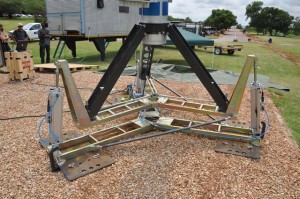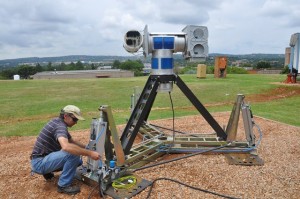Ship motion simulator for accurate maritime surveillance footage
 The CSIR undertakes research and development to support the South African Navy and Special Forces with maritime surveillance using radar systems, sensor technology and rapid response mechanisms to monitor or defend the sovereignty of the country’s oceanic terrain.
The CSIR undertakes research and development to support the South African Navy and Special Forces with maritime surveillance using radar systems, sensor technology and rapid response mechanisms to monitor or defend the sovereignty of the country’s oceanic terrain.
One specific area of interest is the use of optronics for improved surveillance at sea. The CSIR developed a novel camera-based surveillance system that provides a real-time, 360 degree video view of a ship’s surrounds, and that is able to detect and zoom in on small targets. However, the system has to provide a stable view – despite being used on board a constantly moving vessel. To deal with this challenge, the optronics team devised a motion simulator that emulates the ship’s movement at sea based on pneumatics and custom mechanical design, which was done by Hendrik Theron and Mark Holloway. This means that continued development of the camera system could be done on land, and not even near the ocean – as well as giving the assurance that the eventual system will deliver effective visual outputs, despite the roll and pitch of the ship it is used on.
The ship motion simulator is a modified version of a six degrees of freedom Stewart platform (Hexapod). It operates on a roll and pitch axis at different frequencies and amplitudes using a combination of pneumatic actuators and position feedback into a custom control system. In this way, optronics experts could be sure that the camera system will be effective despite the challenges of shifting horizons, changing clouds and water swells obscuring objects.
The CSIR has made the simulator available to the University of Pretoria’s Department of Mechanical Engineering to support postgraduate research on mathematical modelling and control systems studies. The ship motion simulator’s control system was developed through this collaboration.
Using this same methodology, the team will also be looking at motion platforms to support systems on mobile land-based patrol or response vehicles.
 Optronics in maritime security
Optronics in maritime security
The navy’s duty to protect the sovereignty of the state includes involvement in search and rescue missions, harbour-based criminal activity and the scourge of poaching and smuggling of South Africa’s wildlife, such as abalone.
Real-time, 360 degree surveillance is the ‘golden chalice’ in security; having that ‘all seeing eye’ to detect clearly what is happening in the full spectrum of your surroundings in order to respond rapidly and appropriately. Optronic sensors offer an important complementary choice of surveillance to the generally used radar systems on ships. It is better able to detect even small objects (e.g. smaller wooden boats often used by poachers) against the highly cluttered background of waves and white caps. The CSIR’s camera-based surveillance system consists of five high-resolution cameras, each capturing a section of the surrounds. Footage is then ‘stitched together’ to create a real-time, 360 degree video-based view of the entire area surrounding a vessel.
Meet the man behind the ship motion simulator, Hendrik Theron
Hendrik Theron leads the CSIR’s optomechatronics research group. He started at the CSIR as a bursar in 1989 and has been in the mechatronics industry for eight years. He is responsible for the modelling of the ship motion simulator, validation of the model as well as the non-linear control system used. “We need the system to refine tracking performance of surveillance systems and we need to emulate platform motion,” says Theron.
dpss@csir.co.za
